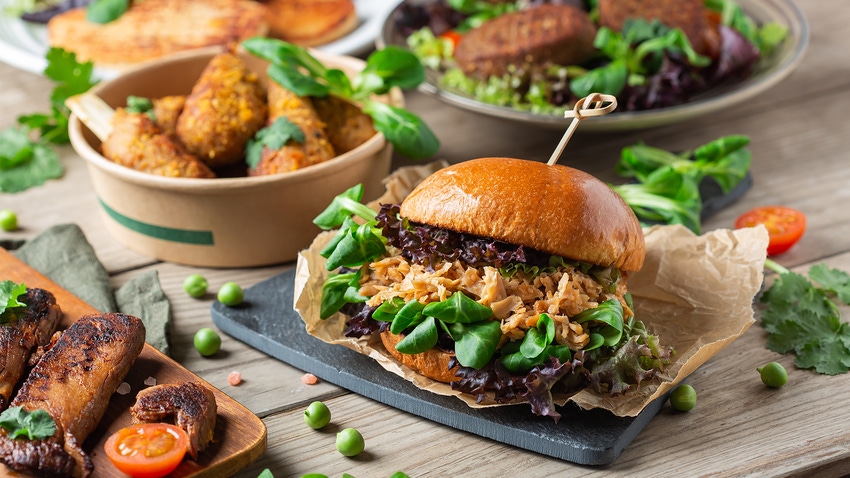Undercover ingredients provide damage control to challenging formulations
As food and beverage developers face challenges in creating plant-based products that mimic the taste, texture and appearance of traditional animal products, new ingredients like upcycled citrus fiber and next-generation plant proteins are proving to be part of the solution.

At a Glance
- Consumers expect plant-based products to compete with animal products, but they often lack the necessary functionalities.
- New ingredients are emerging to address these challenges, including upcycled citrus fiber and next-generation proteins.
- Consumers and regulators are wary of synthetic preservatives, so natural botanical solutions are gaining traction.
Food and beverage developers are busy enough trying to formulate products that tick all the “trending” boxes today’s consumers find so compelling: low sugar, clean label, plant based, natural, better-for-you, etc.
It may be the paradox of our age, however, that while chasing such trends, brands inadvertently create for themselves an entirely new set of sensory and stability challenges that threaten to put their products’ hard-earned trending appeal at risk.
Are they chasing a lost cause? Not at all, now that suppliers have cooked up a cadre of “undercover ingredients” that stand out precisely for blending in.
High bars to clear
When asked to pick her choice for today’s most formidable formulation challenge, Sarah Ferguson, culinologist at CuliNEX, said, “Without doubt, I’d have to say plant based. I’m happy the category’s made the leaps and bound over the last 10 years, but it is a challenging arena to work within.”
Not only does the sheer novelty of building alt-meat and alt-dairy products from plants pose R&D hurdles, but consumers’ also arguably unrealistic expectations raise those hurdles even higher.
“Consumers think that a product that mimics a nonplant food should resemble that food in taste, texture and appearance, and that there should be little to no change on the consumer’s part in terms of behavior,” Ferguson said.
Plants aren’t animals
In other words, a plant-based cheddar “should have a similar taste and texture to traditional dairy cheese, whether cold—say, sliced on a cracker—or used in hot applications like nachos, burgers and baked dishes,” Ferguson explained. “And it should melt at the temperature and rate that consumers expect for those cooking methods, too.”
In the case of a plant-based salmon, consumers not only anticipate the same taste as from something caught in icy Alaskan waters, but the same color change and flakiness, she said, “as indicators of doneness,” as well.
Because plant proteins vary so widely in their stability, functionality and protein content, it’s a rare occasion when one option covers all these bases. Factor in plant proteins’ notoriously grainy texture and beany, bitter astringency and, as Ferguson puts it, “Often, it comes down to finding a protein that does some of what you need because they can’t do everything the way dairy protein can—yet.”
No silver bullet
Jennifer Stephens, VP of marketing at Fiberstar Inc., agreed. “There is no single ingredient that mimics the texture and taste of cooked animal flesh,” she said.
As for recreating dairy, “Plant-based products like yogurts, spreads and ice creams tend to have shelf-stability issues, with water migration being the biggest downfall, while oat and almond milks typically require stabilizers to prevent separation,” she added.
Not just any stabilizer, however, will suffice. “The clean label movement is forcing product developers to look beyond the traditional starches, gums and emulsifiers that strike many consumers as suspicious,” Stephens explained. “Now that they’re reading labels more, ingredient statements need to be short, recognizable and able to roll off the tongue.”
Upcycled fiber
That’s where ingredients like Fiberstar’s upcycled natural citrus fiber, Citri-Fi, offer a clean label solution.
Stephens said that ingredients in the line’s 100 series emulsify and bind water to create the juiciness and succulence consumers expect from plant-based meats, while Citri-Fi TX—a coarse particulate—produces a firm, meat-like texture. “When product developers use them together, they create high-quality meat substitutes like patties, sausages and meatballs,” she said.
In nondairy beverages, Citri-Fi generates a full-bodied mouthfeel, while maintaining “clean” stability, she noted, and in plant-based yogurts and ice cream, it binds water to control syneresis and support the silky-smooth texture consumers love.
Best of all, the ingredient appears on labels as citrus fiber, dried citrus pulp or citrus flour, “all of which resonate well in ‘natural’ markets,” according to Stephens.
Next-gen proteins
Turning to the frontiers of protein tech, suppliers are “working on next-generation plant proteins, even as they optimize the current portfolio, modify other ingredients to support functionality and provide maskers to help with any off notes,” Ferguson said. “In combating the challenges of plant proteins, we can use flavor and bitterness maskers to calm their grainy, beany notes and modulators to help manage gritty texture or even enzymes to break down larger protein molecules—as long as we don’t need those larger molecules for functionality.”
Buffers can protect against denaturation, she added, and come in handy when a protein “can’t hold an emulsion alone.” As ingredients like functional citrus fiber prove, “It’s getting easier to do all of this while also respecting brand and grocer guardrails, as well,” Ferguson maintained.
Clean preservation
Wherever those guardrails lie, “Products have to be preserved as best as possible during their shelf-life to maintain their healthfulness and sensorial characteristics,” Emanuele Moret, R&D manager at Layn Natural Ingredients, said.
With consumers and regulators alike casting a jaundiced eye on synthetic preservatives, he emphasized the value of “natural,” botanical solutions for extending shelf-life, preserving quality and reducing waste.
“The products in our Plantae Preservation platform are clear examples of how natural extracts, when expertly combined, can replace the usual synthetic antioxidants—BHA, BHT, TBHQ—and preservatives like sorbates, benzoates and propionates,” he said.
Not only does “rigorous testing” affirm their effectiveness and minimal sensory impact in applications ranging from meat and bakery to seasoning mixes and pet food, as an added bonus, they’re “pure, sustainably produced and contain no additives or carriers,” according to Moret.
“It’s important to clarify that these products aren’t ‘disguised’ antioxidants or preservatives, and in fact, contain no rosemary or tocopherols nor any sorbates or nitrates,” he explained. Why? Because some manufacturers use botanical extracts as additive carriers. Rowan (Sorbus aucuparia) extract for sorbic acid, for example, or acerola (Malpighia emarginata) extract for ascorbic acid—and “it’s believed that these practices are considered ineffective as well as a deceptive with regard to legislation,” Moret added.
Cause for optimism
Chalk that up as yet another behind-the-scenes complication of contemporary product development. Optimistic realists like Ferguson, however, remain undaunted.
“Suppliers are doing amazing things to accommodate our needs,” she said. And not a moment too soon, either: “Consumer trends are constantly changing, and faster than ever. The solution is reacting fast, pivoting if needed and partnering with the right supplier and manufacturer teams to get the task accomplished.”
About the Author(s)
You May Also Like






